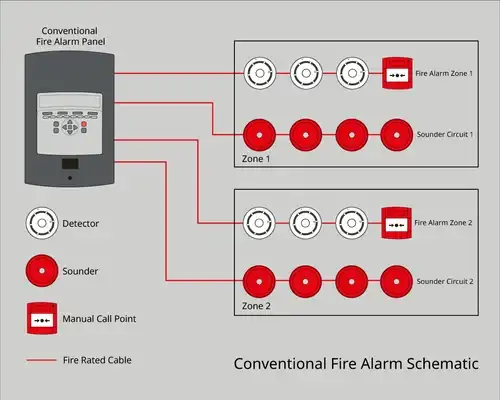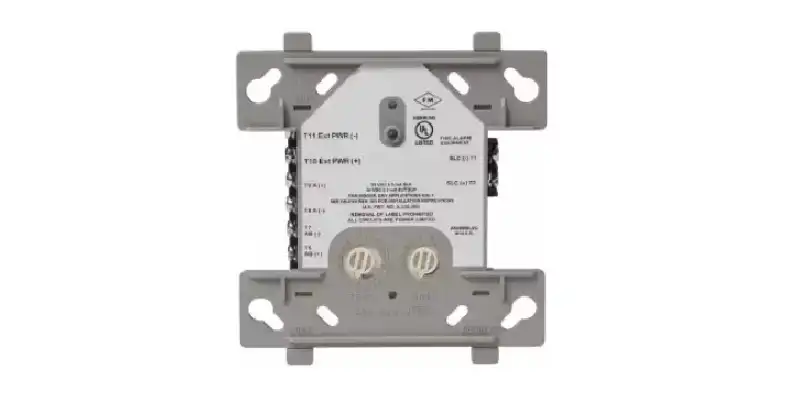I. Вступ
A. Визначення релейних модулів пожежної сигналізації
Релейні модулі пожежної сигналізації - це електронні пристрої, які слугують посередниками між приймально-контрольною панеллю пожежної сигналізації та різними підключеними пристроями в системі виявлення пожежі. Вони працюють як перемикачі, дозволяючи централі активувати або деактивувати такі компоненти, як стробоскопи, сирени, спринклерні системи та системи вентиляції під час пожежі. Полегшуючи зв'язок між централлю та цими пристроями, релейні модулі забезпечують скоординоване реагування на надзвичайні ситуації.
B. Важливість у системах пожежної безпеки
Пожежна сигналізація
Значення релейних модулів пожежної сигналізації в системах пожежної безпеки важко переоцінити. Вони підвищують загальну ефективність і результативність систем виявлення пожежі завдяки кільком ключовим функціям:
- Активація та деактивація пристроїв: Релейні модулі дозволяють точно керувати кількома пристроями, гарантуючи, що тривоги та заходи безпеки активуються оперативно, коли це необхідно.
- Інтеграція з іншими системами: Вони дозволяють інтегрувати системи пожежної сигналізації з іншими системами управління будівлею, такими як системи опалення, вентиляції та кондиціонування повітря і системи безпеки. Така інтеграція має вирішальне значення для управління димовидаленням і забезпечення безпечної евакуації під час надзвичайних ситуацій.
- Ізоляція несправностей: Релейні модулі допомагають ізолювати несправності в системі, дозволяючи відключати несправні пристрої без порушення загальної функціональності системи. Ця можливість є життєво важливою для підтримання операційної цілісності під час пожежі.
- Аварійне керування живленням: У разі відключення електроенергії релейні модулі можуть керувати аварійними джерелами живлення, щоб забезпечити працездатність критично важливих систем.
- Налаштування та гнучкість: Адаптивність релейних модулів дозволяє створювати індивідуальні конфігурації на основі конкретних планів будівель і вимог безпеки, що підвищує їх ефективність в різних умовах.
II. Розуміння модулів реле пожежної сигналізації
A. Основна функція та робота
Релейні модулі пожежної сигналізації є важливими компонентами систем пожежної сигналізації, що виконують роль перемикачів, які керують активацією та деактивацією різних електричних пристроїв під час пожежі. Коли система пожежної сигналізації виявляє потенційну загрозу, вона надсилає невеликий електричний сигнал на релейний модуль. Цей сигнал активує реле, яке замикає набір контактів для завершення ланцюга, дозволяючи більшому струму від зовнішнього джерела живлення надходити до таких пристроїв, як спринклерні системи, сигналізація або системи димовидалення. Цей механізм дозволяє системі пожежної сигналізації ефективно керувати кількома пристроями, не перевантажуючи систему, забезпечуючи швидке реагування в надзвичайних ситуаціях.
B. Типи релейних модулів
Існує кілька типів релейних модулів, що використовуються в системах пожежної сигналізації, кожен з яких виконує певні функції:
- Модулі реле керування: Ці модулі видають напругу для активації сигналізації або інших сигнальних пристроїв при спрацьовуванні панелі керування пожежною сигналізацією. Вони зазвичай використовуються для ввімкнення сирен/стробоскопів та інших пристроїв сповіщення.
- Модулі реле моніторингу: Вони призначені для моніторингу певних ланцюгів або пристроїв, наприклад, тягових станцій або датчиків диму, і повідомляють про їхній стан на контрольну панель. Вони можуть допомогти інтегрувати старі системи в сучасні адресні системи.
- Вихідні релейні модулі: Часто їх називають просто релейними модулями, вони можуть перемикати великі навантаження і використовуються для керування зовнішніми пристроями, такими як дверні тримачі або системи опалення, вентиляції та кондиціонування повітря під час аварійних ситуацій.
C. Ключові компоненти
Модулі реле пожежної сигналізації складаються з декількох ключових компонентів, які забезпечують їхню функціональність:
- Вхідні з'єднання: Вони взаємодіють з панеллю керування пожежною сигналізацією, отримуючи сигнали, які вказують, коли спрацьовує пожежна сигналізація.
- Вихідні клеми: Підключаються до зовнішніх пристроїв, якими потрібно керувати, дозволяючи релейному модулю керувати подачею живлення на основі вхідного сигналу.
- Релейні контакти: Внутрішній механізм, який розмикає або замикає ланцюги на основі отриманих сигналів. Контакти можуть бути сконфігуровані у різних формах (наприклад, форма C) для різних застосувань.
- Світлодіодні індикатори: Багато релейних модулів мають світлодіодні індикатори, які забезпечують візуальний зворотний зв'язок про їхній робочий стан - зазвичай вказують, чи знаходяться вони в нормальному стані, чи були активовані через тривожний стан.
III. Переваги релейних модулів пожежної сигналізації
A. Покращена системна інтеграція
Релейні модулі пожежної сигналізації забезпечують безперешкодну інтеграцію між системами виявлення пожежі та іншими системами керування будівлею, наприклад, системами опалення, вентиляції та кондиціонування повітря і системами безпеки. Така інтеграція дозволяє скоординовано реагувати на надзвичайні ситуації, наприклад, контролювати потік повітря, щоб запобігти поширенню диму, або блокувати зони, щоб забезпечити безпечну евакуацію. З'єднуючи різні системи, релейні модулі підвищують загальну безпеку та ефективність протипожежних заходів, гарантуючи, що всі компоненти ефективно працюють разом у критичних ситуаціях.
B. Посилення контролю та моніторингу
Релейні модулі забезпечують розширений контроль над підключеними пристроями, дозволяючи точно активувати та деактивувати їх у реальному часі. Вони дають змогу системам пожежної сигналізації керувати кількома виходами одночасно, наприклад, активувати сигналізацію, стробоскопи та спринклерні системи в разі виявлення пожежі. Крім того, багато сучасних релейних модулів пропонують можливості віддаленого моніторингу, що дозволяє операторам системи контролювати продуктивність і швидко реагувати на будь-які проблеми або тривоги з централізованого місця.
C. Підвищена надійність
Надійність систем пожежної сигналізації значно підвищується завдяки використанню релейних модулів. Ці компоненти розроблені з вбудованими функціями контролю та діагностики, які попереджають операторів про потенційні несправності, запобігаючи таким чином виходу системи з ладу під час надзвичайних ситуацій. Ізолюючи несправні пристрої без шкоди для функціональності всієї системи, релейні модулі гарантують, що система пожежної сигналізації залишатиметься працездатною навіть у разі виходу з ладу окремих компонентів. Ця надійність має вирішальне значення для дотримання стандартів безпеки та відповідності нормативним документам, таким як NFPA 72.
D. Економічна ефективність
Інвестиції в релейні модулі пожежної сигналізації можуть призвести до довгострокової економії коштів для власників і операторів будівель. Покращуючи інтеграцію та надійність системи, ці модулі зменшують ймовірність хибних тривог і непотрібних викликів служби технічної підтримки. Крім того, їхня здатність ефективно керувати кількома пристроями може знизити витрати на встановлення та обслуговування, мінімізуючи складність проводки та систем керування. Загалом, використання релейних модулів сприяє створенню більш раціональної системи пожежної безпеки, яка може адаптуватися до мінливих потреб без значних додаткових витрат.
IV. Застосування релейних модулів пожежної сигналізації
A. Житлові будинки
У житлових приміщеннях релейні модулі пожежної сигналізації підвищують безпеку, інтегруючись із детекторами диму та системами сигналізації для керування сповіщеннями та реагуванням на надзвичайні ситуації. Ці модулі можуть активувати взаємопов'язані сигналізації по всьому будинку, гарантуючи, що тривоги будуть почуті в усіх приміщеннях. Крім того, вони можуть керувати такими системами, як аварійне освітлення або дверні замки, забезпечуючи безпечну евакуацію під час пожежі. Така інтеграція особливо корисна в багатоповерхових будинках або багатоквартирних комплексах, де швидкий зв'язок має вирішальне значення.
B. Комерційні структури
Релейні модулі пожежної сигналізації відіграють життєво важливу роль у комерційних будівлях, підключаючи різні пристрої виявлення пожежі та забезпечуючи дотримання правил безпеки. Вони дозволяють інтегрувати пожежну сигналізацію з системами керування будівлею, забезпечуючи автоматичне розблокування дверей під час надзвичайних ситуацій та активацію систем пожежогасіння. Крім того, релейні модулі допомагають мінімізувати кількість хибних тривог і підвищують загальну надійність заходів пожежної безпеки в таких приміщеннях, як офіси, торгові центри та склади.
C. Промислові об'єкти
На промислових об'єктах застосування релейних модулів пожежної сигналізації є критично важливим через наявність небезпечних матеріалів і складного обладнання. Ці модулі можуть керувати вентиляційними системами для боротьби з димом і теплом під час пожежі, активувати тривоги на великих об'єктах і взаємодіяти з іншими системами безпеки, наприклад, спринклерними установками. Здатність контролювати кілька пристроїв одночасно гарантує, що будь-яка загроза пожежі буде негайно усунена, тим самим захищаючи персонал і майно від потенційних катастроф.
D. Заклади охорони здоров'я
Медичні установи використовують модулі ретрансляції пожежної сигналізації для забезпечення безпеки пацієнтів і персоналу в умовах, коли швидка евакуація може бути ускладнена. Ці модулі можуть інтегруватися з системами виклику медсестер та іншими критично важливими об'єктами інфраструктури для забезпечення своєчасного оповіщення під час пожежі. Вони також полегшують керування димовими бар'єрами та вентиляційними системами для підтримання безпечної якості повітря в медичних закладах. Надійність і швидкість реагування цих модулів мають важливе значення для захисту вразливих груп населення в лікарнях і будинках для людей похилого віку.
V. Як працюють релейні модулі пожежної сигналізації
A. Прийом і передача сигналу
Релейні модулі пожежної сигналізації працюють, отримуючи низьковольтний сигнал від приймально-контрольної панелі пожежної сигналізації (ППКП), коли спрацьовує пожежна тривога. Цей сигнал вказує на те, що виявлено пожежну подію, і спонукає релейний модуль реагувати. Релейний модуль призначений для інтерпретації цього сигналу, який може бути невеликою кількістю електрики, а потім передавати його на підключені пристрої. Наприклад, коли димовий датчик виявляє дим, він надсилає сигнал активації до релейного модуля, який активує свої вихідні контакти для керування зовнішніми пристроями, такими як сигналізація або спринклерні системи.
B. Активація підключених пристроїв
Коли релейний модуль отримує сигнал активації, він замикає свої внутрішні контакти, щоб завершити електричний ланцюг. Ця дія дозволяє більшому струму від зовнішнього джерела живлення надходити до підключених пристроїв, таких як стробоскопи, сирени або системи пожежогасіння. Реле можна налаштувати на різні режими роботи - наприклад, безперервний або імпульсний вихід - залежно від конкретних вимог застосування. Наприклад, в імпульсному режимі реле може активувати пристрій на короткий проміжок часу, а потім автоматично повернутися до початкового стану. Ця функція має вирішальне значення для забезпечення ефективної роботи аварійних пристроїв під час пожежі.
C. Взаємодія з іншими системами будівлі
Релейні модулі пожежної сигналізації також слугують критично важливими інтерфейсами між системами виявлення пожежі та іншими системами керування будівлею (BMS), як-от системами опалення, вентиляції та кондиціонування повітря або системами контролю доступу. Інтегруючись з цими системами, релейні модулі підвищують загальну безпеку та операційну ефективність. Наприклад, вони можуть керувати потоком повітря під час пожежі, контролюючи вентиляційні системи, щоб запобігти поширенню диму, або автоматично розблоковувати двері для безпечної евакуації. Така інтероперабельність не лише покращує час реагування, але й гарантує, що всі системи будівлі працюватимуть злагоджено під час надзвичайних ситуацій, максимізуючи безпеку мешканців та мінімізуючи матеріальні збитки.
VI. Правильний вибір релейного модуля пожежної сигналізації
A. Міркування щодо сумісності
При виборі релейного модуля пожежної сигналізації першорядне значення має сумісність з наявними контрольними панелями та пристроями пожежної сигналізації. Переконайтеся, що релейний модуль призначений для роботи з вашою конкретною системою пожежної сигналізації, наприклад, Silent Knight серії IFP або іншими брендами, такими як Aico. Багато модулів, як-от адресний релейний модуль Farenhyt, мають унікальні адреси шлейфів сигнальної лінії (SLC), які повинні відповідати вимогам централі для ефективного зв'язку та роботи. Крім того, зверніть увагу на те, чи підтримує модуль як нормально розімкнуті, так і нормально замкнуті шлейфи, оскільки ця гнучкість може мати вирішальне значення для різних інсталяцій.
B. Потенціал та можливість розширення
Оцініть здатність релейного модуля обробляти кількість пристроїв, які ви плануєте підключити. Модулі відрізняються за кількістю реле, які вони пропонують; наприклад, деякі з них можуть містити кілька реле Form-C, що забезпечує широкі можливості керування різними системами. Крім того, враховуйте можливість розширення модуля. Деякі системи дозволяють додавати додаткові модулі за потреби, що є корисним для майбутніх модернізацій або розширень без необхідності повної реконструкції системи. Переконайтеся, що будь-який обраний модуль може задовольнити ваші поточні та очікувані потреби.
C. Відповідність нормативним вимогам
Відповідність місцевим і національним нормам пожежної безпеки є критично важливою при виборі модулів реле пожежної сигналізації. Шукайте модулі, сертифіковані визнаними організаціями зі стандартизації, такими як Underwriters Laboratories (UL) або еквівалентними органами у вашому регіоні. Ці сертифікати гарантують, що модуль відповідає суворим критеріям безпеки та продуктивності. Крім того, перевірте, чи відповідає модуль реле відповідним кодексам, наприклад NFPA 72, який регулює системи пожежної сигналізації в США. Дотримання цих норм не тільки підвищує безпеку, але й допомагає уникнути потенційної юридичної відповідальності, пов'язаної з їхньою невідповідністю.
VII. Встановлення та обслуговування
A. Найкращі практики встановлення
- Розміщення та підключення: Релейні модулі пожежної сигналізації повинні бути стратегічно розташовані так, щоб мінімізувати відстань прокладання кабелів і забезпечити оптимальне покриття. Таке розміщення підвищує цілісність сигналу та зменшує складність монтажу.
- Сумісність: Переконайтеся, що релейний модуль сумісний з конкретною системою пожежної сигналізації, що встановлюється, включаючи вимоги до напруги та протоколи зв'язку. Цей крок має вирішальне значення для ефективної роботи.
- Дотримання стандартів: Дотримуйтесь місцевих протипожежних норм і правил, наприклад, CAN/ULC-S524 в Канаді, який визначає правила встановлення систем пожежної сигналізації. Сюди входить належна висота монтажу (наприклад, модулі слід встановлювати на висоті не вище 1800 мм над чистовою підлогою) і забезпечення доступу для технічного обслуговування.
- Професійне встановлення: Залучайте кваліфікованих фахівців для встановлення, щоб гарантувати відповідність стандартам безпеки та оптимальну функціональність релейних модулів.
B. Вимоги до регулярного тестування та обслуговування
- Регулярне тестування: Проводьте регулярні тести для перевірки функціональності модулів реле пожежної сигналізації та пов'язаних з ними пристроїв. Сюди входить перевірка правильності зміни стану реле в разі спрацьовування панелі керування пожежною сигналізацією (ППКП) і належної реакції під'єднаних пристроїв.
- Планове обслуговування: Дотримуйтесь рекомендацій виробника щодо планового технічного обслуговування, щоб продовжити термін служби релейних модулів. Це може включати очищення, перевірку з'єднань і заміну будь-яких зношених компонентів.
- Документація: Ведіть докладні записи всіх випробувань і робіт з технічного обслуговування, включаючи дати, результати і вжиті коригувальні дії. Ця документація необхідна для дотримання нормативних вимог і для подальшого використання.
C. Вирішення поширених проблем
- Відсутність сигналу: Якщо модуль реле не активує підключені пристрої, перевірте, чи немає несправностей у проводці або ослаблених з'єднань між модулем і ППКП чи вихідними пристроями. Переконайтеся, що живлення на модуль подається належним чином.
- Хибні тривоги: Дослідіть потенційні причини хибних спрацьовувань, наприклад, фактори навколишнього середовища або несправні датчики, які можуть неправильно спрацьовувати в релейному модулі. Для вирішення цих проблем можуть знадобитися налаштування або заміна.
- Світлодіодні індикатори: Багато релейних модулів мають світлодіодні індикатори, які забезпечують візуальний зворотний зв'язок щодо їхнього робочого стану. Якщо світлодіод не світиться, коли повинен, це може вказувати на несправність або проблему з живленням, яка потребує негайної уваги.
- Зверніться до інструкцій виробника: Завжди звертайтеся до інструкцій виробника з усунення несправностей для вирішення конкретних проблем, пов'язаних з їхніми продуктами, оскільки вони можуть запропонувати індивідуальні рішення на основі проектних специфікацій.
VIII. Виробники релейних модулів пожежної сигналізації
Ханівелл.
- Веб-сайт: honeywell.com
- Honeywell пропонує адресні релейні модулі Farenhyt, призначені для використання з панелями керування пожежною сигналізацією серії Silent Knight IFP. Ці модулі оснащені декількома реле Form-C та гнучкими можливостями програмування.
Айко.
- Веб-сайт: aico.co.uk
- Дротовий релейний модуль Ei128R від Aico живиться від мережі і підключається до систем сигналізації для запуску зовнішніх пристроїв, таких як стробоскопи і телекомунікаційні пристрої. Він сумісний з різними серіями сигналізацій Aico.
C-Tec
- Веб-сайт: discountfiresupplies.co.uk
- C-Tec пропонує ряд релейних модулів, придатних для систем пожежної сигналізації 24В, включаючи ізольовані реле та ізолятори допоміжних пристроїв.
Фіке.
- Веб-сайт: fike.com
- Система Cheetah Xi від Fike використовує інтелектуальні релейні модулі, які взаємодіють між собою, забезпечуючи швидкий час реагування та широкі можливості програмування для систем пожежної безпеки.
IX. Висновок
Вибір правильного релейного модуля, забезпечення належного встановлення, а також дотримання графіків регулярного тестування та технічного обслуговування мають важливе значення для отримання максимальної вигоди від цих пристроїв. Оскільки правила пожежної безпеки стають дедалі суворішими, роль релейних модулів у забезпеченні їх дотримання та захисті життя і майна тільки зростатиме.
На закінчення, релейні модулі пожежної сигналізації є важливим компонентом сучасної інфраструктури пожежної безпеки, пропонуючи поєднання технологічного прогресу, надійності та адаптивності, що є необхідним для вирішення проблем протипожежного захисту в 21 столітті.
X. Поширені запитання
A. У чому різниця між звичайними та адресними релейними модулями?
Звичайні релейні модулі є частиною старих систем пожежної сигналізації, в яких кожен пристрій підключається до централі окремими проводами для кожного пристрою або зони. Це означає, що якщо спрацьовує тривога, панель вказує лише на зону, де сталася тривога, що вимагає від персоналу подальшого розслідування, щоб знайти точне джерело тривоги. На противагу цьому, адресні релейні модулі є частиною більш просунутих систем, де кожен пристрій має унікальну адресу на одній лінії зв'язку. Це дозволяє централі визначити точне місце розташування тривоги, надаючи більш детальну інформацію та покращуючи час реагування під час надзвичайних ситуацій.
B. Як часто слід тестувати релейні модулі пожежної сигналізації?
Модулі реле пожежної сигналізації слід випробовувати щонайменше раз на рік як частину комплексного плану пожежної безпеки. Однак, на основі місцевих правил або конкретних будівельних вимог може бути рекомендовано проводити частіші випробування. Регулярне тестування гарантує, що всі компоненти працюють належним чином, а будь-які несправності можна швидко виявити та усунути. Крім того, щомісячні перевірки візуальних індикаторів (наприклад, світлодіодних індикаторів) допоможуть переконатися, що модулі працюють.
C. Чи можна вбудовувати релейні модулі пожежної сигналізації в існуючі системи?
Так, модулі реле пожежної сигналізації часто можна вбудовувати в існуючі системи, особливо при переході від звичайних до адресних систем. Багато виробників пропонують модулі моніторингу, які дозволяють старішим пристроям стати адресними без повної заміни. Однак, щоб забезпечити належну функціональність і відповідність стандартам безпеки, необхідно перевірити сумісність з наявними компонентами.
D. Чи бездротові релейні модулі пожежної сигналізації такі ж надійні, як і дротові?
Бездротові релейні модулі пожежної сигналізації можуть бути надійними, але загалом залежать від конкретної технології, що використовується, та факторів навколишнього середовища. Дротові модулі зазвичай забезпечують більшу надійність завдяки стабільному живленню та несприйнятливості до перешкод від фізичних перешкод або електронних пристроїв. Однак розвиток бездротових технологій значно підвищив їхню надійність, що робить їх придатними для багатьох застосувань, особливо в сценаріях модернізації, де прокладання нових проводів є недоцільним. Зрештою, вибір між дротовими та бездротовими технологіями повинен враховувати конкретні умови встановлення, регуляторні вимоги та дизайн системи.
Джерело статті:
https://en.wikipedia.org/wiki/Fire_alarm_system
https://blog.dga.com/fire-relays-integrating-access-control-and-fire-systems




